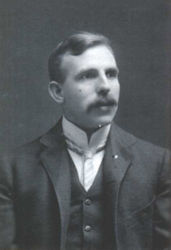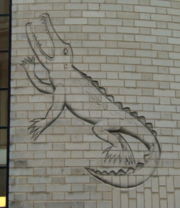Ernest Rutherford
2007 Schools Wikipedia Selection. Related subjects: British History 1750-1900; Engineers and inventors
 Ernest Rutherford, 1st Baron Rutherford of Nelson |
|
| Born | August 30, 1871 Spring Grove, New Zealand |
|---|---|
| Died | October 19, 1937 Cambridge, England |
| Residence | UK |
| Nationality | New Zealand-English |
| Field | Physicist |
| Institution | McGill University University of Manchester |
| Alma Mater | University of Canterbury Cambridge University |
| Known for | Being the 'father' of nuclear physics |
| Notable Prizes | Nobel Prize in Chemistry 1908 |
| Note that he is the father-in-law of Ralph Fowler. Note that although Rutherford did not have a PhD, J. J. Thomson is considered to be the equivalent of his doctoral mentor. | |
Ernest Rutherford, 1st Baron Rutherford of Nelson OM PC FRS ( 30 August 1871 – 19 October 1937), was a nuclear physicist from New Zealand. He was known as the "father" of nuclear physics, he pioneered the orbital theory of the atom, in his discovery of Rutherford scattering off the nucleus with the gold foil experiment.
Early years
Rutherford was born at Spring Grove, (now in Brightwater), near Nelson, New Zealand. He studied at Nelson College and won a scholarship to study at Canterbury College, University of New Zealand. In 1895, after gaining his BA, MA and BSc, and doing two years of research at the forefront of electrical technology, Rutherford travelled to England for postgraduate study at the Cavendish Laboratory, University of Cambridge (1895- 1898), and was resident at Trinity College. There, he briefly held the world record for the distance over which electromagnetic waves could be detected. During the investigation of radioactivity he coined the terms alpha, beta, and gamma rays.
Middle years
In 1898 Rutherford was appointed to the chair of physics at McGill University, in the country of Canada, where he did the work which gained him the 1908 Nobel Prize in Chemistry. He had demonstrated that radioactivity was the spontaneous disintegration of atoms. He noticed that in a sample of radioactive material it invariably took the same amount of time for half the sample to decay — its " half-life" — and created a practical application for this phenomenon using this constant rate of decay as a clock, which could then be used to help determine the actual age of the Earth that turned out to be much older than most scientists at the time believed.
In 1907 he took the chair of physics at the University of Manchester. There he directed the Geiger-Marsden experiment that discovered the nuclear nature of atoms and was the world's first successful "alchemist": he converted nitrogen into oxygen. While working with Niels Bohr (who discovered that electrons moved in specific orbits) Rutherford theorized about the existence of neutrons, which could somehow compensate for the repelling effect of the positive charges of protons by causing an attractive nuclear force and thus keeping the nuclei from breaking apart.
Later years
He was knighted in 1914. In 1917 he returned to the Cavendish as Director. Under him, Nobel Prizes were awarded to Chadwick for discovering the neutron (in 1932), Cockcroft and Walton for splitting the atom using a particle accelerator and Appleton for demonstrating the existence of the ionosphere. He was admitted to the Order of Merit in 1925 and in 1931 was created Baron Rutherford of Nelson of Cambridge in the County of Cambridge, a title which became extinct upon his death.
Impact and legacy
His research, along with that of his protege, Sir Mark Oliphant was instrumental in the convening of the Manhattan Project. He is famously quoted as saying: "In science there is only physics; all the rest is stamp collecting." He is also reputed to have stated that the idea of using nuclear reaction to generate useful power was "moonshine".
Things named after Rutherford include:
- the element rutherfordium, Rf, Z=104. (1997)
- craters on Mars and the Moon
- a building of the modern Cavendish Laboratory in the University of Cambridge, UK
- the physics and chemistry building at the University of Canterbury, New Zealand
- the physics building at McGill University, Montreal, Canada
- Rutherford College, a school in Auckland, New Zealand
- a house at his own high school, Nelson College
- a house at Rangiora High School, Rangiora, New Zealand
- a house at Macleans College, Auckland, New Zealand
- a house at Cashmere High School, Christchurch, New Zealand
- a college at the University of Kent in Canterbury, UK
- a lecture theatre at the University of Manchester.
At the site of the original Cavendish Laboratory in Cambridge, there is an engraving by Eric Gill on the side of the Mond Laboratory: it was commissioned by Rutherford's colleague Peter Kapitza, whose nickname for Rutherford was "the crocodile".
- Rutherford was the subject of a play by Stuart Hoar.
- Rochester and Rutherford Hall a boarding house at the University of Canterbury, Christchurch, New Zealand
Quote
"The energy produced by the atom is a very poor kind of thing. Anyone who expects a source of power from the transformation of these atoms is talking moonshine." 1933
"All science is either physics or stamp collecting", in J. B. Birks "Rutherford at Manchester" (1962)
"I have always been proud of the fact that I am a New Zealander", Auckland 1925
"It was almost as incredible as if you fired a fifteen inch shell at a piece of tissue paper and it came back to hit you", on the particle scattering experiment 1909

